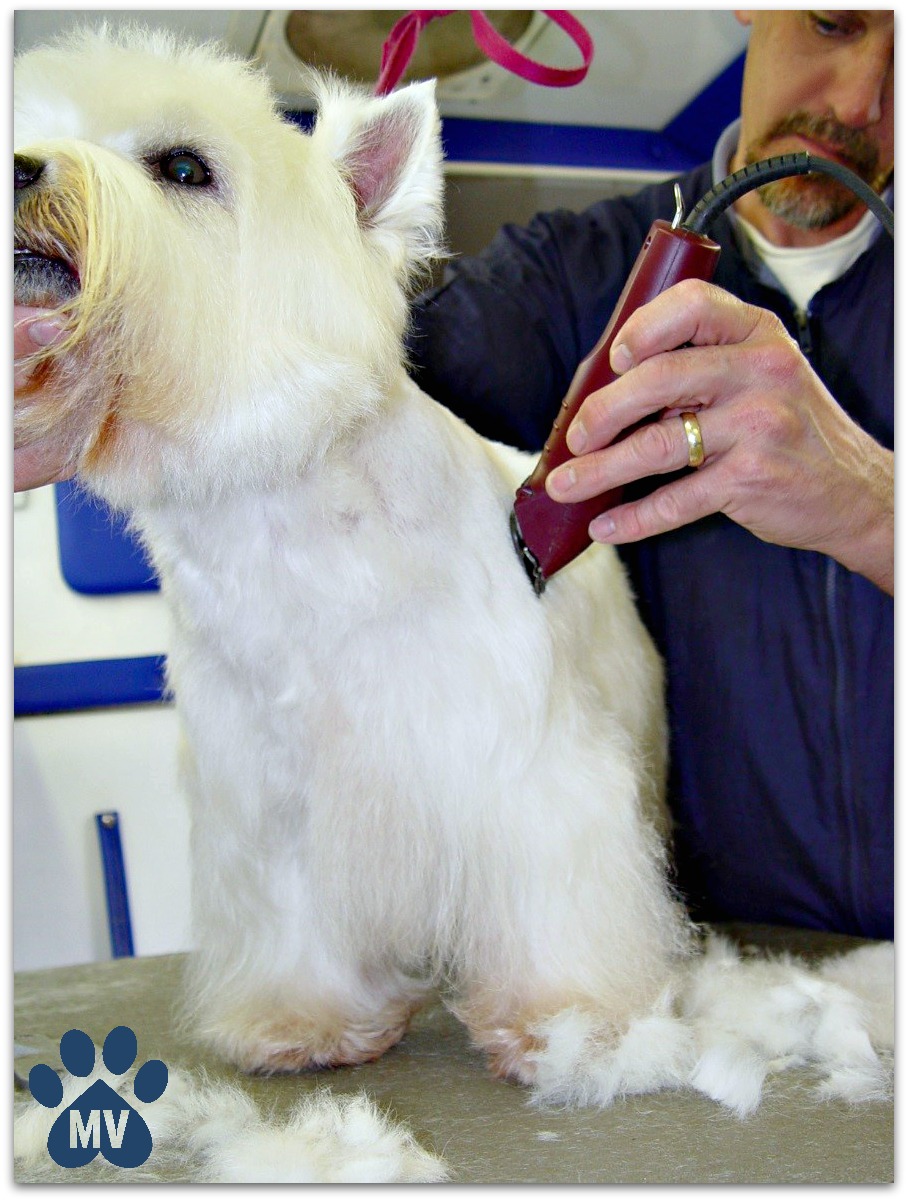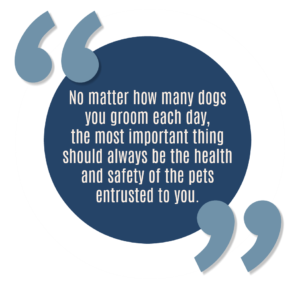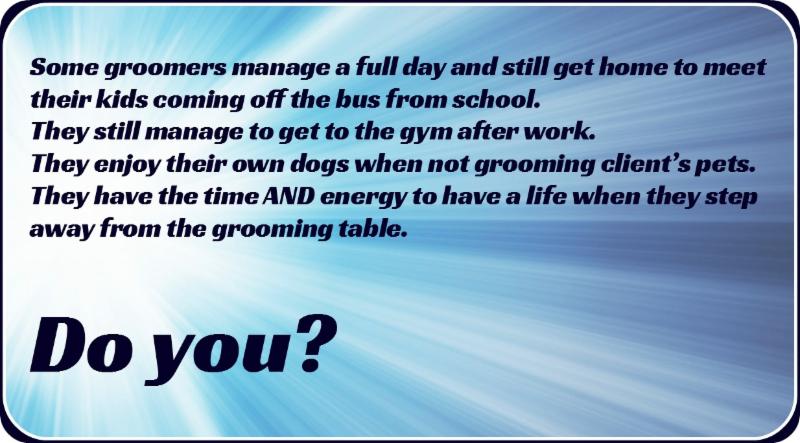I often say there are shades of gray in pet grooming.
 How many dogs a day you should groom is one of the BIG gray areas! The number will be different for everybody. Some people feel overwhelmed grooming even three dogs in a full day. Other people can do 16 while barely breaking a sweat.
How many dogs a day you should groom is one of the BIG gray areas! The number will be different for everybody. Some people feel overwhelmed grooming even three dogs in a full day. Other people can do 16 while barely breaking a sweat.
Here are just a handful of the scenarios affecting the number of dogs that might be groomed in a day.
- Level of grooming experience
- Work space setup
- Equipment
- Salon location
- Salon type
- Size of salon/mobile setup
- Working solo or with assistance
- Pet size
- Type of grooms – low maintenance, bath and brush, show trim styles
- Personal motivation
- Your personality
- Financial need
I’m sure you could add a few more to this list!
Typically, when someone first graduates from grooming school or is new to the industry, productivity is not high on their skill list. Rather, their focus is on thoroughness, quality, and safety.
New groomers will improve their speed as they develop skills and confidence. They need experience. They need coaching. They need guidance to create an effective grooming system. The system allows thoroughness while enhancing the quality of their work and the pace in which they do it.
If you’re a seasoned pet stylist, you’ve learned many of the tricks that allow you to be efficient. You’ve learned how to quickly assess a pet and easily determine its grooming needs. You are thorough. You work safely. You have a strong base of repeat customers.
Over the years I’ve seen beginners struggle to get through three dogs. I’ve seen highly efficient, seasoned stylists get through 16 or more dogs in the single day and still have the time and energy to have a little “me time” that evening. Where do you fall on the scale? Where would you like to be?
Being able to work quickly and skillfully can also be impacted by the layout of your work space. Are you set up for maximum efficiency? A bad layout will add unnecessary footsteps to your day and waste your time and energy.
 Your equipment, tools, and products will also help or hurt you. Many products will enhance your speed and the quality of your final product. Do you have access to high-quality, time-saving, products and tools? When used correctly, they are well worth the investment and can help you groom more pets efficiently.
Your equipment, tools, and products will also help or hurt you. Many products will enhance your speed and the quality of your final product. Do you have access to high-quality, time-saving, products and tools? When used correctly, they are well worth the investment and can help you groom more pets efficiently.
If you are a solo stylist either in your own salon or mobile setting, 6 to 8 dogs will likely be your maximum. In addition to grooming pets, independent business owners have a wide range of duties and responsibilities. They are the receptionist, the bookkeeper, the marketer, the janitor, and the record keeper – along with every other task it takes to run a successful business. If you are a mobile stylist, you also have driving and van maintenance added to your list of responsibilities.
Efficiency comes into play when pet grooming establishments start building a team. You cannot build a successful business or team with inefficient team members. Inefficient teams will not be able to groom as many pets as their efficient counterparts.
Financial need affects dog numbers. To get a decent paycheck, everyone needs to pull their weight. If you are hired onto a team or work with an assistant, you will have quotas to meet. Some quotas are determined by dog numbers. Other businesses use financial sales volume. Both help determine how many dogs are groomed each day.
Typically, once you start working with others, dog volume increases. In most salons, a team of people working together will be expected to do a minimum of eight dogs a day or more. When you’re working within a team, everybody has a specialty. Each person can focus on what they do best, whether it’s customer service, bathing and drying, or pet trimming and styling. If you have an assistant doing the bathing and drying for you, the number of pets might jump from 6-8 to 12-14. Let’s face it – bathing and drying dogs takes time! If a shop has a good bather/prepper, you can easily groom more pets in a day.
The type of trim combined with the sizes of dogs being done will make a huge difference in how many pets can be done each day. A #7F All on a six-week regular Shih Tzu is much different from a longer guard comb trim with stylized scissored legs. What happens if you increase the size of the dog? Larger dogs simply take much more time. To me, a Doodle is the equivalent of two or three smaller dogs, depending on the type of haircut it is getting.
For many pet professionals, WHY you groom pets will also influence how many dogs you groom in a day. One of the amazing things about our industry is we all love dogs. There are those who really enjoy taking their time with the grooming process and will groom fewer pets. There are those who will try to help as many pets as they can in a single day. Others enjoy the creativity. Some enjoy the flexibility the career offers while others are motivated by the career opportunities. There are also groomers that simply enjoy earning a living by doing something they love.
How many dogs should you groom each day? There are lots of gray areas so there is no right answer. Whatever your motivation, no matter how many dogs you groom each day, the most important thing should always be the health and safety of the pets entrusted to you.
Happy trimming!
Melissa
 Do you agree with this post? Jump on the Learn2GroomDogs.com Facebook page and tell us why or why not.
Do you agree with this post? Jump on the Learn2GroomDogs.com Facebook page and tell us why or why not.




 P.S. How do you build teamwork in your salon?
P.S. How do you build teamwork in your salon? 

 Generally speaking, the faster you can get a dog to the tub, the faster the trim will go. Dogs with six weeks or less coat growth can normally go straight to the tub. With today’s products, shampoos, conditioners, and high velocity dryers, much of the pre-work can be eliminated. Dematting or pre-trimming is a waste of time with six weeks or less trims.
Generally speaking, the faster you can get a dog to the tub, the faster the trim will go. Dogs with six weeks or less coat growth can normally go straight to the tub. With today’s products, shampoos, conditioners, and high velocity dryers, much of the pre-work can be eliminated. Dematting or pre-trimming is a waste of time with six weeks or less trims.